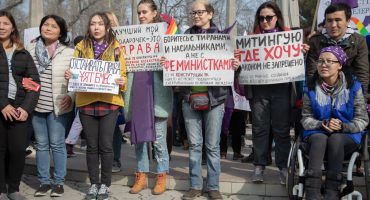Human Rights Day is celebrated by the global community on December 10 every year. The CABAR.asia media school together with lawyers of the Coalition Against Torture in Kyrgyzstan have gathered all important things about human rights, their characteristics, and ways of protection into 11 cards.
Human rights are the rights that we have just because we are humans.
They are not granted by any state. Universal human rights are the inherent rights of each of us regardless of citizenship, sex, national or ethnic background, skin colour, religion, language or any other signs. They include both basic rights, including right to life, and rights that make our life decent, including right to food, education, work, health and freedom.
The key notion in the human rights concept is the inherent dignity. It is related to the very essence of humanity, comes from the very fact that someone is a human; human rights belong to both a baby who has not done anything good or bad in their life, and to the most notorious criminal.
Human dignity should be differentiated from personal dignity, which is close to honour – it should be earned, it is growing when we behave honourably and decently, or it can be lost if we behave meanly.
Human rights and freedoms are the shield, cover, protecting the dignity of every human from abuses by the authorities. They do not guarantee that we will be loved, happy, successful; they do not even guarantee us justice or at least welfare – they just protect us from dishonour, offences to our dignity by one, yet the most powerful of potential offenders – the state power.
Human rights are inherent. No one may be deprived of rights, but for certain cases and according to due legal procedures. For example, the right to liberty may be restricted if the court finds a person guilty of a crime.
Moreover, human rights are indivisible and interdependent. It means that one category of rights may not be exercised without another category. For example, the progress in civil and political rights makes it easier to implement economic, social and cultural rights. Moreover, violation of economic, social and cultural rights may have a negative impact on many other rights.
It’s the Universal Declaration of Human Rights. It was adopted in 1948 by the UN General Assembly. It was recognised so widely that its initially non-binding nature changed and now it is often referred to as the legally binding document of the customary international law.
The Universal Declaration of Human Rights consists of the preamble and 30 articles, which set forth human rights and basic freedoms, which are inherent to all men and women in the world, without any discrimination. It covers all civic and political rights, social, economic and cultural rights.
The basic intenrational treaties in the field of human rights and their implementation bodies are listed here.
Human rights develop all the time, their list is extended both in domestic legal systems, and in international law. Thus, new rights and freedoms are formulated and procedures that will effectively secure their implementation are being explored.
For example, the digital age has revealed new opportunities for greater prosperity of people, increase in their knowledge and for scientific researches. However, the use of new technologies today lead to violations of the rights of citizens and their privacy by surveillance, repressive measures, online harassment, and spreading of hatred.
The violator of these rights – the state – must be their key defender. The existing national laws, political decisions, procedural norms and mechanisms must be key factors for human rights implementation in every country.
Therefore, it is important to make human rights a part of national constitutional and legislative systems so that professional lawyers could apply human rights standards in practice, and violations of human rights could be condemned and penalised.
There are regional and intenrational organisations that can report violations of rights at the national level. Concern or assistance by the regional or international community can help restore the rights in a given country. However, this is done only after all domestic remedies have been used and exhausted.
However, the fact of recognition of human rights and freedoms is of little importance once there are no procedures that allow everyone to effectively protect against violations of such rights.
At the national level, these are courts if human rights protection documents have been ratified or included into the national legislation. Also, depending on the country, they are available in the ombudsman offices, in human rights committees, human rights councils, parliamentary committees, etc. The key international supervisory bodies are commissions and committees or courts consisting of independent members – experts or judges, and none of these bodies should consist of representatives of only one state.
In their activities, these bodies apply the following key mechanisms:
- complaints (filed by individuals, groups of persons or states);
- lawsuits;
- procedures for report submission.
There are two types of treaties: legally binding and non-binding.
Binding documents are most often called treaties, conventions or covenants. They mean the state’s obligation to secure the rights at the national level. Each individual state claims its commitment to adopt these standards by ratifying them or joining the document (mere signing of the document does not make it binding, but proves the intention to contribute).
According to the 1979 Vienna Convention on the law of treaties, the states may formulate reservations or statements, thus exempting itself of some obligations under the treaty. However, it’s better if the state promises to observe at least some human rights than none at all.
The majority of human rights treaties demand that the states submit human rights reports. The purpose of such reports is to share honest opinions, with the participation of a relevant supervisory body, to share complex issues faced by the parties when protecting respective rights.
Reports submitted by the states are discussed in parallel with “shadow” (alternative) reports submitted by NGOs that are related to a given state and based on their own sources and analysis.
In addition to participation in a dialogue with the states, supervisory bodies may also be authorised to study the human rights situation on site by getting first-hand information. The majority of such trips may require official authorisation of the state for investigation of specific cases.
Title photo: sites.uab.edu
This publication was produced as part of the mentorship programme under the Development of New Media and Digital Journalism in Central Asia project delivered by the Institute for War and Peace Reporting (IWPR) with support from the UK Government. It does not necessarily reflect the official views of IWPR or the UK Government
If you have found a spelling error, please, notify us by selecting that text and pressing Ctrl+Enter.





